
468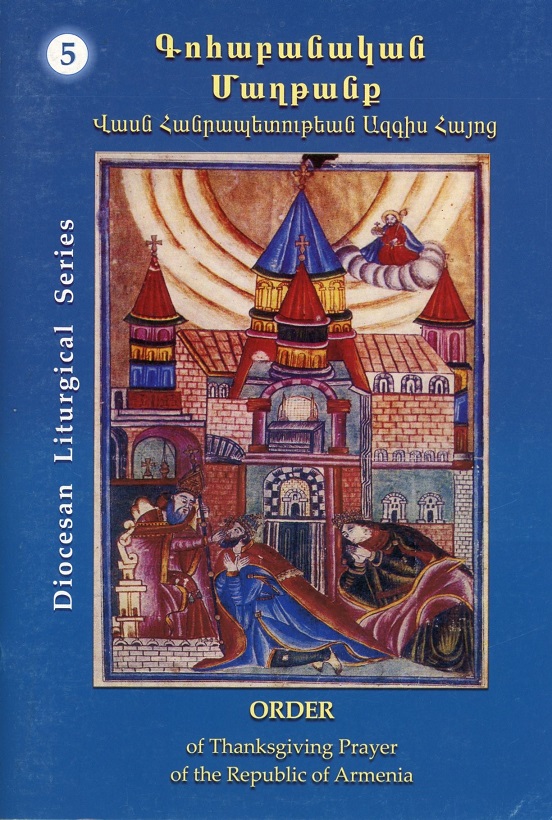 Rangement Bible, etc.
 | | Order of Thanksgiving Prayer of the Republic of Armenia |
| Titre : | Order of Thanksgiving Prayer of the Republic of Armenia / auteur(s) : Armenian Church of America - |
|---|
| Editeur : | Diocesan Liturgical Committee |
|---|
| Année : | 2009 |
|---|
| Imprimeur/Fabricant : | St. Vartan Press |
|---|
| Description : | 16 x 23,5 cm, 14 pages, couverture illustrée en couleurs |
|---|
| Collection : | Diocesan Liturgical series 5 |
|---|
| Notes : | |
|---|
| Autres auteurs : | |
|---|
| Sujets : | |
|---|
| ISBN : | |
|---|
| Lecture On-line : | non disponible |
|---|
Commentaire : |
467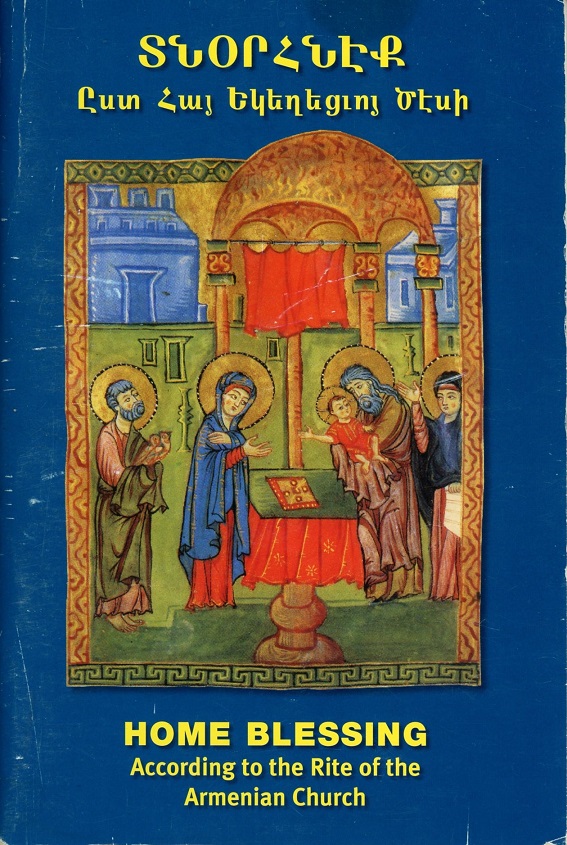 | | Home blessing according to the Rite of the Armenian Church |
| Titre : | Home blessing according to the Rite of the Armenian Church / auteur(s) : Armenian Church of America - |
|---|
| Editeur : | Diocesan Liturgical Committee |
|---|
| Année : | 2007 |
|---|
| Imprimeur/Fabricant : | Printed iin Canada |
|---|
| Description : | 16,5 x 24 cm, 42 pages, couverture illustrée en couleurs |
|---|
| Collection : | |
|---|
| Notes : | |
|---|
| Autres auteurs : | |
|---|
| Sujets : | |
|---|
| ISBN : | |
|---|
| Lecture On-line : | non disponible |
|---|
Commentaire : |
205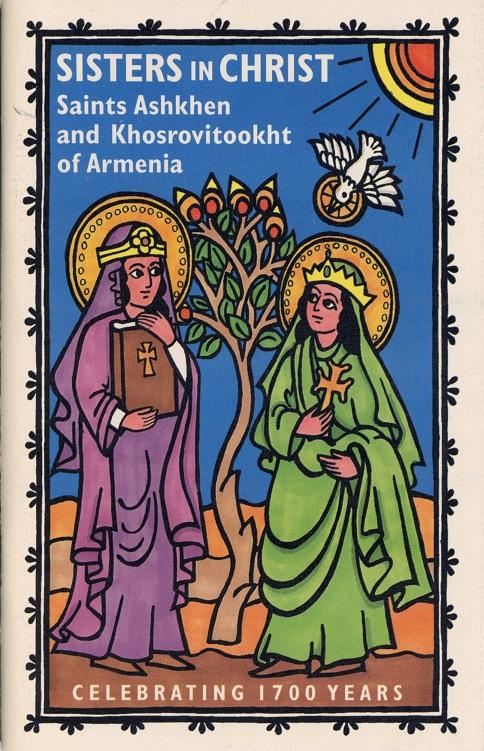 Rangement général
 | | Sisters in Christ, saints Askhen and Khosrovitookht of Armenia |
| Titre : | Sisters in Christ, saints Askhen and Khosrovitookht of Armenia / auteur(s) : Armenian Church of America - Celebrating 1700 years |
|---|
| Editeur : | Armenian Church of America |
|---|
| Année : | 2001 |
|---|
| Imprimeur/Fabricant : | |
|---|
| Description : | 14 x 21,5 cm, 36 pages, couverture illustrée en couleurs |
|---|
| Collection : | |
|---|
| Notes : | |
|---|
| Autres auteurs : | |
|---|
| Sujets : | Armenian Church -- saints Askhen and Khosrovitookht |
|---|
| ISBN : | |
|---|
| Lecture On-line : | non disponible |
|---|
Commentaire :This year (2001), Diocesan Women Saints Day honors the blessed lives and contributions of Queen Ashkhen and Princess Khosrovitookht.
Their legendary role in the conversion of Armenia is a story told from generation to generation. And yet, there is very little historical information about these women.
We do not know what they looked like. We do not know how they dressed or what sort of education and experience palace life offered except from the anecdotal details of other royal histories of earlier or later eras. We do not know what their precise influence on the realm was. As women, were they "invisible"? Or did they inspire respect and perhaps even fear from Drtad's advisors? Did the court have its royal intrigues and its influential "power behind the throne"—perhaps these very two women—as in the later medieval world with which we are more familiar?
Very recently, an archaeological dig in ancient Dvin has revealed the foundations of the palace of King Drtad's son. But it has yet to share the secrets of daily life in his father's palace and of its three key players who continue to excite the imagination to this very year, the 1700th anniversary of their decision to unequivocally declare,
"Here I am, Lord."
These pages offer some modest resources for deeper spiritual reflection. |
311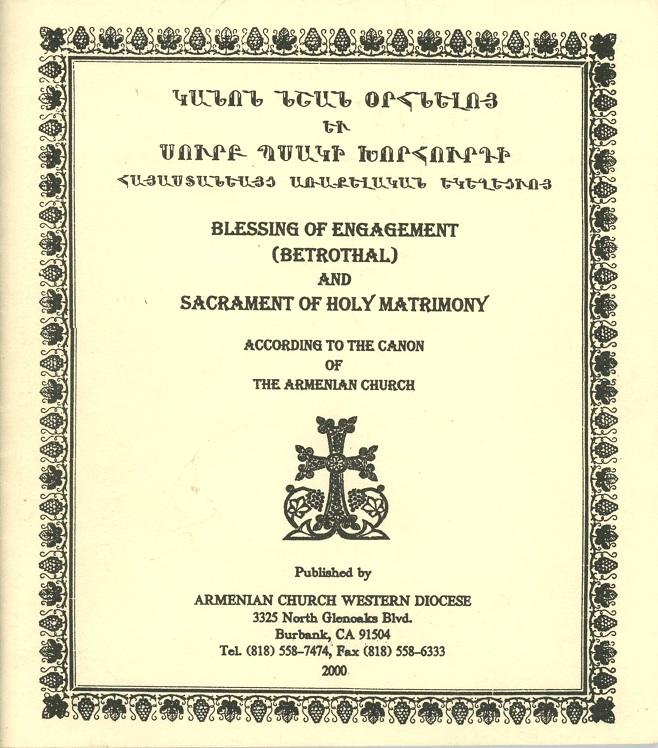 Rangement général
 | | Blessing of engagement (Betrothal) and Sacrament of Holy matrimony |
| Titre : | Blessing of engagement (Betrothal) and Sacrament of Holy matrimony / auteur(s) : Armenian Church of America - According to the canon of the Armenian Church |
|---|
| Editeur : | Armenian Church of America |
|---|
| Année : | 1998 |
|---|
| Imprimeur/Fabricant : | |
|---|
| Description : | 19 x 21 cm, 51 pages |
|---|
| Collection : | |
|---|
| Notes : | |
|---|
| Autres auteurs : | |
|---|
| Sujets : | Armenian Church sacraments |
|---|
| ISBN : | |
|---|
| Lecture On-line : | non disponible |
|---|
Commentaire : |
312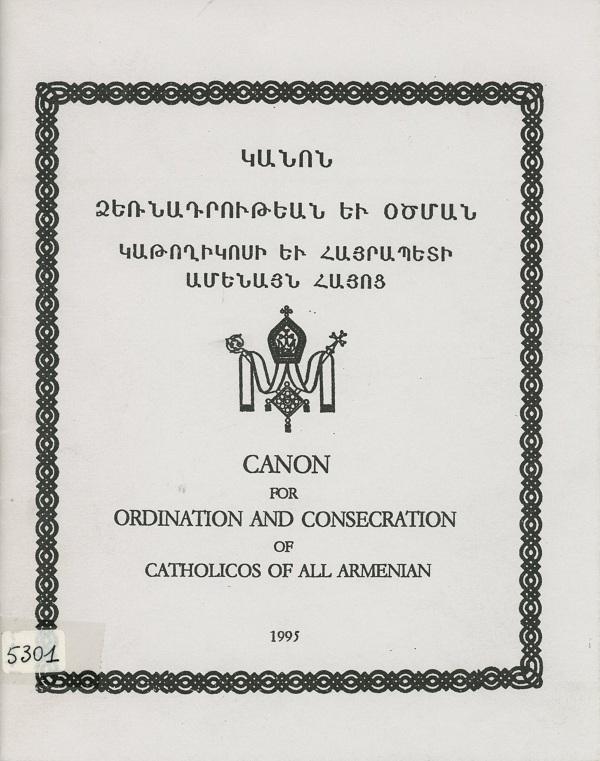 Rangement général
 | | Canon for ordination and consecration of Catholicos of all Armenian |
| Titre : | Canon for ordination and consecration of Catholicos of all Armenian / auteur(s) : Armenian Church of America - |
|---|
| Editeur : | Armenian Church of America |
|---|
| Année : | 1995 |
|---|
| Imprimeur/Fabricant : | |
|---|
| Description : | 17,5 x 21,5 cm, 44 pages |
|---|
| Collection : | |
|---|
| Notes : | |
|---|
| Autres auteurs : | |
|---|
| Sujets : | |
|---|
| ISBN : | |
|---|
| Lecture On-line : | non disponible |
|---|
Commentaire : |
313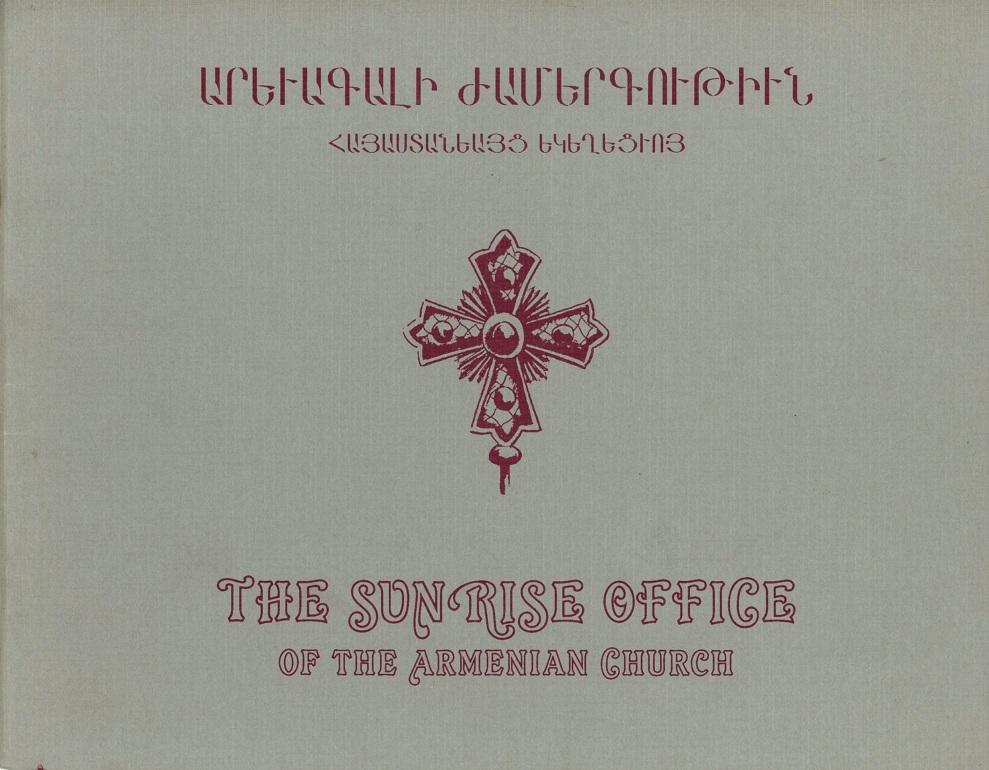 Rangement général
 | | The sunrise office of the Armenian Church |
| Titre : | The sunrise office of the Armenian Church / auteur(s) : Armenian Church of America - |
|---|
| Editeur : | Armenian Church of America |
|---|
| Année : | 1994 |
|---|
| Imprimeur/Fabricant : | |
|---|
| Description : | 24 x 19 cm, 42 pages, couverture illustrée en noir et blanc |
|---|
| Collection : | |
|---|
| Notes : | |
|---|
| Autres auteurs : | |
|---|
| Sujets : | |
|---|
| ISBN : | |
|---|
| Lecture On-line : | non disponible |
|---|
Commentaire : |
259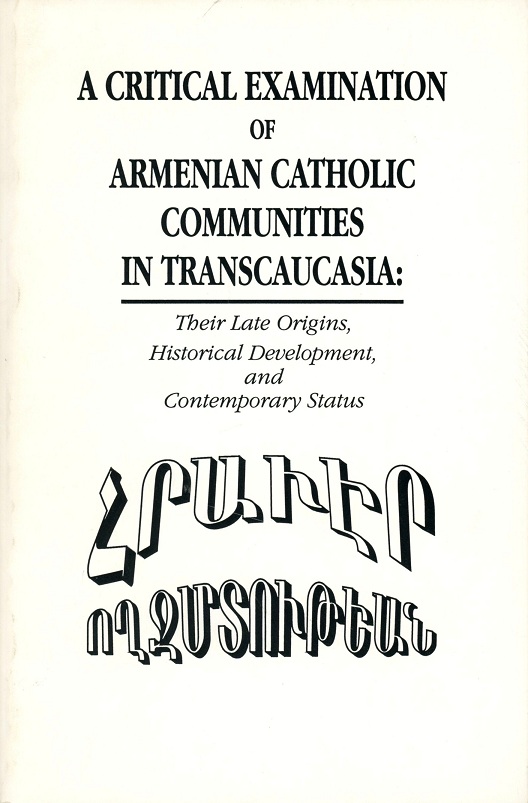 Rangement général
 | | A critical examination of Armenian catholic communities in Transcaucasia |
| Titre : | A critical examination of Armenian catholic communities in Transcaucasia / auteur(s) : Armenian Church of America - |
|---|
| Editeur : | Armenian Church of America |
|---|
| Année : | 1994 |
|---|
| Imprimeur/Fabricant : | USA |
|---|
| Description : | 15 x 23 cm, 223 pages |
|---|
| Collection : | |
|---|
| Notes : | |
|---|
| Autres auteurs : | |
|---|
| Sujets : | Armenian Church -- Catholic Church |
|---|
| ISBN : | |
|---|
| Lecture On-line : | non disponible |
|---|
Commentaire :EDITOR'S FORWARD The following essays were composed in response to a Circular-Letter issued by Catholicos-Patriarch John Peter XVIII Kasparian, the Uniate Patriarch of Cilicia. The text of the Circular-Letter, related documents, and an account of the circumstances surrounding the publication and reception of the letter are available in The Mother Church and Roman Catholic Missionary Activity in a Reborn Armenia (St. Vartan Press, New York, 1993).
Like its predecessor, the present volume is divided into two parts: the essays in the first part are English translations of documents originally written in Armenian; the second part presents the same essays in their original form. In translating the texts, we have aimed at clarity, while maintaining the greatest possible fidelity to the original. In places, some expansion was required, and these are duly noted within the text. Elaborations and clarifications by the translator are so attributed and enclosed in brackets; these are distinguished from an author's expansions upon his own quoted sources, which are followed by the author's initials and enclosed in parentheses.
The editors are aware that these essays combine a certain combative rhetorical style with genuine scholarship. (It should be added that such rhetoric may be the appropriate way to respond to the original Circular-Letter, which was itself more a lengthy editorial than a work of scholarship.) Professor Hakopian's implied characterization of the doctrine of papal infallibility, or his equation of assimilation and annihilation as merely different forms of genocide, may reasonably be seen as questionable interpretations. Whether such passages represent a serious defect in the exegesis of historical data is another matter.
In anticipation of critics of these essays, the editors maintain that such sentimental flourishes should not deter us from extracting something of scholarly value from the essays. That valuable information, reflected in the title of the present volume, consists in tracing the historical origins of the Catholic communities in Armenia, and charting their development to the present. This component stands on its own, and deserves serious attention by disinterested scholars. Needless to say, the same analysis explodes the historical speculations presented in the original Circular-Letter.
One further insight may be deduced from the following essays, although it is nowhere stated explicitly. Surely the central point of controversy between the Armenian Church and the Roman Catholic Church is the latter's claim to universality. What is at issue in Catholicos-Patriarch John Peter's Circular-Letter—and what ultimately emerges as the issue in this volume—is whether the Armenian Church exists under the authority of Rome. Patriarch John Peter seems to regard the independent Armenian Apostolic Church as a kind of aberration, and suggests that any legitimate apostolic church of Armenia must be subsidiary to the Roman Catholic Church, which he regards as the Universal Church. A logical response, however, is that the very existence of an Armenian-rite Catholic church— whose liturgical traditions and norms for priestly celibacy, e.g., diverge from the rest of Catholicism—contradicts such universalist claims. Either the norms of Catholicism are universally applicable, in which case there should be no separate Armenian-rite Catholic church, or the attempt to create in the Armenian Catholic church a "weigh-station" between an autonomous Armenian Apostolic tradition and full subsumption under Rome must be seen as a kind of devious power-play, characteristic of an Italian tradition of quite a different vintage.
The editors of the present volume do not claim to read into the intentions of churchmen of previous centuries. As for the present century, relations between the sees of Etchmiadzin and Rome are good. The current pope, John Paul II, is a stirring and admirable leader; his sharpening of the great moral arguments of the day has been a benefit to all branches of the Christian religion. Rome has a genuine claim to the leadership of the Christian world in this sense—but in this sense alone.
Certainly, the history of this past century has reminded all followers of the living Christ that our common adversary is the secular "culture of death," to use Pope John Paul's powerful phrase, evident in its obvious forms of fascism and communism, but also in a more subtle form which has resulted in the dissolution of the family, civil unrest and philosophical nihilism in the West. As terrible as these developments are, there may be a kind of divine purpose in them, if in response Christians are persuaded to focus more fully on moral matters, and away from hierarchical or institutional ones. We offer these thoughts as a token of our desire for a cessation of inter-communal hostilities, and as an invitation to a deeper friendship in the cause of truth.
C. H. Z., New York City, 1994 |
351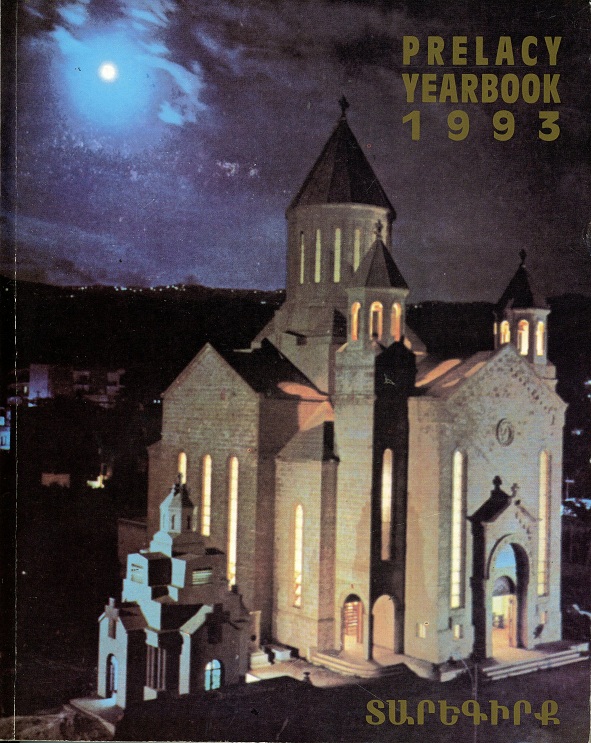 Rangement général
 | | Prelacy Yearbook 1993 |
| Titre : | Prelacy Yearbook 1993 / auteur(s) : Armenian Church of America - |
|---|
| Editeur : | Armenian Church of America |
|---|
| Année : | 1993 |
|---|
| Imprimeur/Fabricant : | |
|---|
| Description : | 20,5 x 25 cm, 224 pages, pages de notes libres |
|---|
| Collection : | |
|---|
| Notes : | |
|---|
| Autres auteurs : | |
|---|
| Sujets : | Yearbook |
|---|
| ISBN : | |
|---|
| Lecture On-line : | non disponible |
|---|
Commentaire : |
258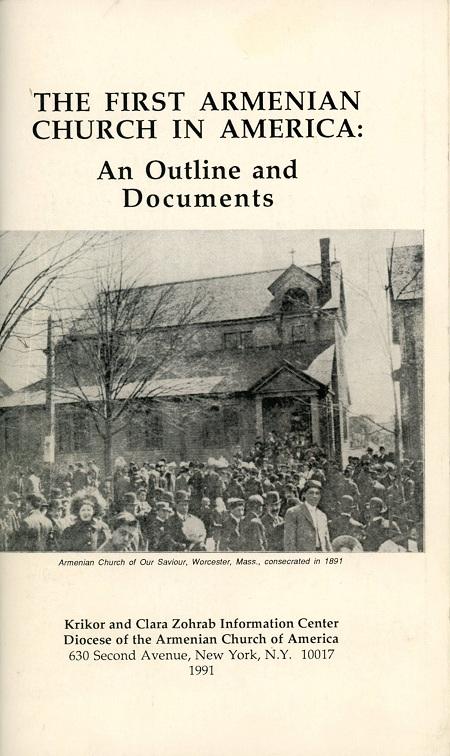 Rangement général
 | | The first Armenian church in America : An Outline and Documents |
| Titre : | The first Armenian church in America : An Outline and Documents / auteur(s) : Armenian Church of America - |
|---|
| Editeur : | Armenian Church of America |
|---|
| Année : | 1991 |
|---|
| Imprimeur/Fabricant : | USA |
|---|
| Description : | 13,5 x 20,5 cm, 134 pages, couverture illustrée en noir et blanc |
|---|
| Collection : | |
|---|
| Notes : | |
|---|
| Autres auteurs : | |
|---|
| Sujets : | Armenian Church |
|---|
| ISBN : | |
|---|
| Lecture On-line : | non disponible |
|---|
Commentaire :Preface The founding of the first Armenian Church in the Americas (in Worcester, Massachusetts) and the development of this church into the center of the Diocese of the Armenian Church of America began with the immigration of Armenians from the Ottoman Empire in the late nineteenth century, and their need for communal identity and organization. They were thousands of miles from their ancestral homeland, away from their families and traditional leaders, in a very different type of society. The formation of an organized Armenian community was a difficult process, involving conflicts between various groupings as well as simple personality clashes. It also was difficult to find clergymen who were able to adapt to the conditions of the new community. In spite of such obstacles, the foundations of a religious and community life were set for future generations of Armenians in America.
TABLE OF CONTENTS
Preface.......
Introduction.
Chapter 1
The Formation of the Worcester Armenian Community..............1
Chapter 2
The First Armenian Priest in America..............1 0
Chapter 3
The First Church. .......................1 5
Chapter 4
The Library Association: Conflict between Pastor and
Church Members..............1 7
Chapter 5
Successors of Fr. Sarajian..............20
Chapter 6:
The Establishment of the Armenian Diocese in America............28
Epilogue..............32
Sources..............33
APPENDICES
Introduction..............35
Appendix A: Documents..............3 6
Appendix B: The Constitution of the Diocese of America and Commentary..............101
CREDITS......134
|
207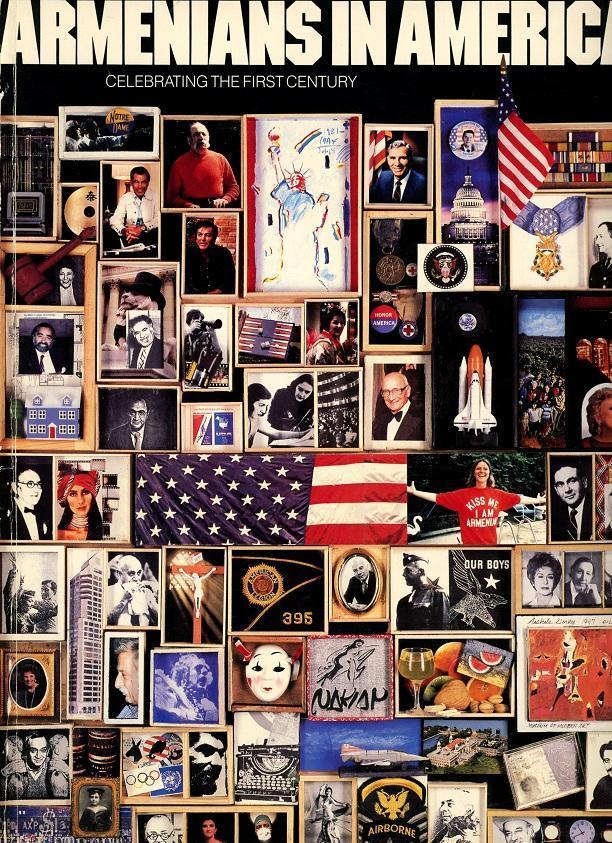 Rangement général
 | | Armenians in America |
| Titre : | Armenians in America / auteur(s) : Armenian Church of America - Celebrating the first century |
|---|
| Editeur : | Armenian Church of America |
|---|
| Année : | 1987 |
|---|
| Imprimeur/Fabricant : | |
|---|
| Description : | 23 x 30 cm, 96 pages, couverture illustrée en couleurs |
|---|
| Collection : | |
|---|
| Notes : | |
|---|
| Autres auteurs : | |
|---|
| Sujets : | Armenians in America -- Biography of famous Armenian-Americans |
|---|
| ISBN : | |
|---|
| Lecture On-line : | non disponible |
|---|
Commentaire :This commemorative book celebrates the growth and achievements of the vibrant community of Armenians in America, who rose from the ashes of genocide to build a new home in a new land. Although some Armenians emigrated to the United States as early as the 1600!$, the largest influx of Armenians began after the 1890's—hence the first century of Armenians in America—from the 1890's to the 1990s. The Armenian Assembly is proud to offer this book as a testament to the thousands of Armenian-Americans who liave contributed their talents to make this country a better place to live.
The future holds many challenges for Armenians in America and each of us must play a role in helping shape our community's responses to the issues we will face. The Armenian Assembly looks forward to the growing involvement of Armenian-Americans in America's future.
Jirair Haratunian Chairman, Board of Directors |
211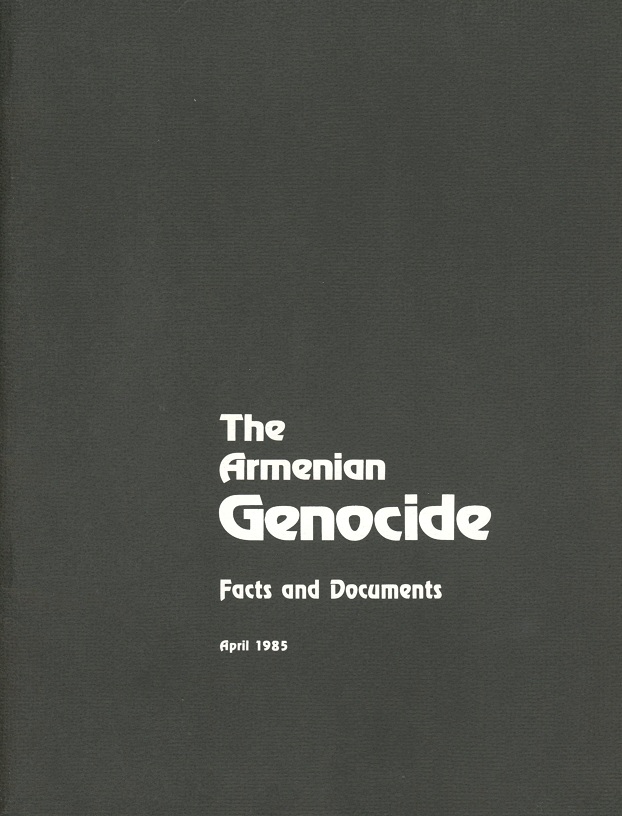 Rangement général
 | | The Armenian Genocide, Facts and Documents |
| Titre : | The Armenian Genocide, Facts and Documents / auteur(s) : Armenian Church of America - April 1985 |
|---|
| Editeur : | Armenian Church of America |
|---|
| Année : | 1985 |
|---|
| Imprimeur/Fabricant : | St Vartan Press |
|---|
| Description : | 21,5 x 28 cm, 51 pages |
|---|
| Collection : | |
|---|
| Notes : | |
|---|
| Autres auteurs : | |
|---|
| Sujets : | Armenian genocide |
|---|
| ISBN : | |
|---|
| Lecture On-line : | non disponible |
|---|
Commentaire :For most of us it is hard to be dispassionate about anything relating to the Armenian Genocide.
But to those who can be, the ensuing pages are valuable documents providing a first-hand testimony about the events leading to the culmination of the intensive massacres of the Hamidian era.
These historical outlines serve also as echoes and reinforcement of the unequivocal purpose of the Turkish government to eliminate the Armenian presence in Anatolia. It is ironic that one of the leaders of the "architects" of the Genocide, Talaat Pasha, would unflinchingly announce his plans to destroy the entire Armenian population, but one . . . "and that for the museum."
Particularly useful in these pages are the documented arguments correcting the myths and the misleading facts the Turkish government wants the world to believe. Perhaps the most telling is the statement of Norbert de Bischoff, hagiographer of Kemalism, made in 1936 that "the sword of justice must strike the guilty; but the sword of history strikes the weak."
The Armenian people, having survived the ordeal, remain steadfast to their faith and heritage, continuing to prosper in their homeland and in diaspora.
Now, let justice speak up!
Archbishop Torkom Manoogian Primate
April 24, 1985, New York |
227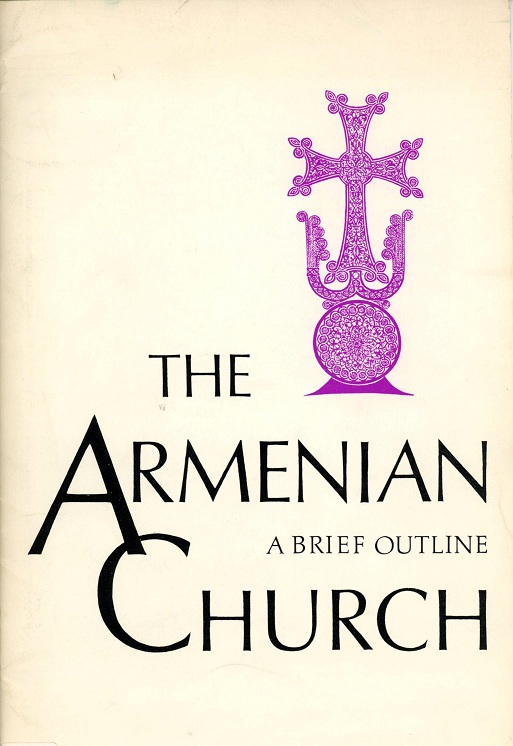 Rangement général
 | | The Armenian Church, A brief outline of her history and hierarchical Sees |
| Titre : | The Armenian Church, A brief outline of her history and hierarchical Sees / auteur(s) : Armenian Church of America - |
|---|
| Editeur : | Armenian Church of America |
|---|
| Année : | 1973 |
|---|
| Imprimeur/Fabricant : | New York |
|---|
| Description : | 18 x 27 cm, 32 pages, couverture illustrée en couleurs |
|---|
| Collection : | |
|---|
| Notes : | |
|---|
| Autres auteurs : | |
|---|
| Sujets : | Armenian Church |
|---|
| ISBN : | |
|---|
| Lecture On-line : | non disponible |
|---|
Commentaire :The Church of Armenia acknowledges as its original founders two of the twelve apostles of Christ, Thaddeus and Bartholomew, who are referred to as the "first enlighteners of Armenia" to distinguish them from the second enlightener, St. Gregory. According to tradition the two apostles were put to death in Armenia. The generally accepted chronology gives a period of eight years to the mission of St. Thaddeus (35-43 A.D.) and sixteen years to that of St. Bartholomew (44-60 A.D.).
Since there existed no Armenian alphabet until the first part of the fourth century, we have very little information concerning the progress of Christianity in Armenia before the official conversion. But there are strong indications that Christianity had taken root in the country at a much earlier time. Recently discovered fragmentary documents refer to certain bishops as successors to the two apostles. History records religious persecutions by at least three kings of Armenia during the years 110, 238, and 280. Moreover, the Armenian Church commemorates many Armenian martyrs of the apostolic era. Eusebius, the church historian, mentions a letter by Dionysius, Patriarch of Alexandria, written to Mehroujan, Bishop of Armenia. It thus follows that Christianity had not only made inroads in Armenia, but had taken more or less organized form with bishops who were well known outside of Armenia. |
85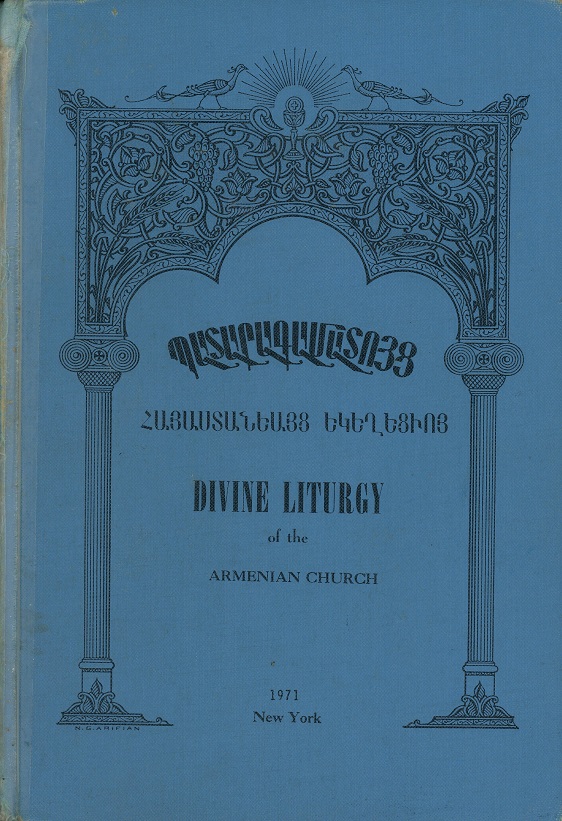 | | Divine Liturgy of the Armenian Church |
| Titre : | Divine Liturgy of the Armenian Church / auteur(s) : Armenian Church of America - |
|---|
| Editeur : | Armenian Church of America |
|---|
| Année : | 1971 |
|---|
| Imprimeur/Fabricant : | |
|---|
| Description : | 16,5 x 23,5 cm, 82 pages |
|---|
| Collection : | |
|---|
| Notes : | |
|---|
| Autres auteurs : | |
|---|
| Sujets : | |
|---|
| ISBN : | |
|---|
| Lecture On-line : | non disponible |
|---|
Commentaire : |
400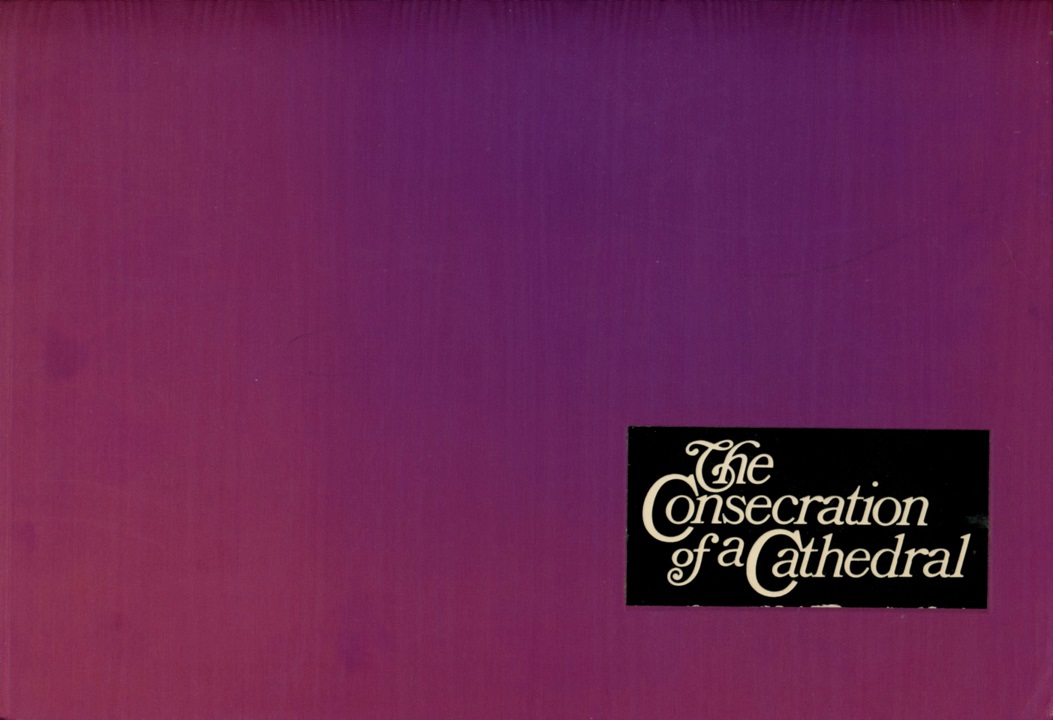 Rangement Beaux-livres
 | | Consecration of a Cathedral |
| Titre : | Consecration of a Cathedral / auteur(s) : Armenian Church of America - |
|---|
| Editeur : | Armenian Church of America |
|---|
| Année : | 1969 |
|---|
| Imprimeur/Fabricant : | USA |
|---|
| Description : | 30 x 28 cm, 28 pages + album photographique |
|---|
| Collection : | |
|---|
| Notes : | |
|---|
| Autres auteurs : | |
|---|
| Sujets : | Consécration de la Cathédrale St-Vartan à New York |
|---|
| ISBN : | |
|---|
| Lecture On-line : | non disponible |
|---|
Commentaire : |
310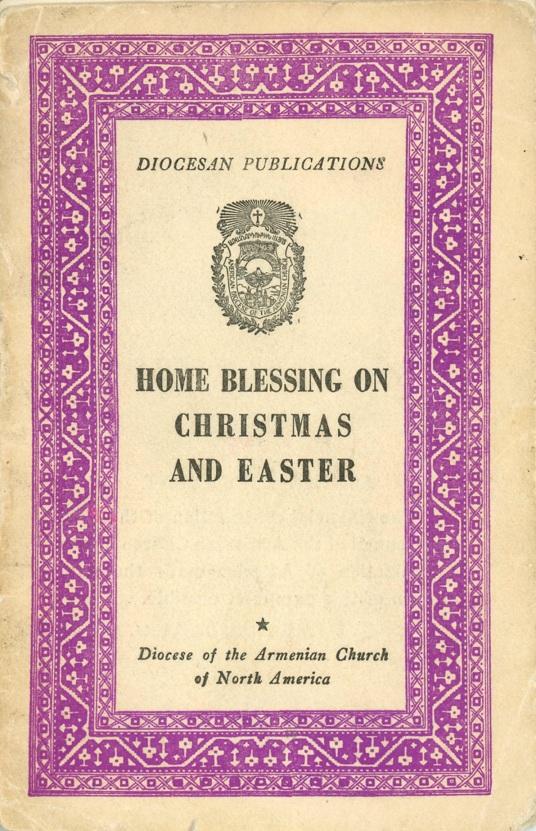 Rangement général
 | | Home blessing on Christmas and Easter |
| Titre : | Home blessing on Christmas and Easter / auteur(s) : Armenian Church of America - |
|---|
| Editeur : | Armenian Church of America |
|---|
| Année : | 1965 |
|---|
| Imprimeur/Fabricant : | |
|---|
| Description : | 10,5 x 18 cm, 20 pages, couverture illustrée en couleurs |
|---|
| Collection : | Diocesan publications |
|---|
| Notes : | |
|---|
| Autres auteurs : | |
|---|
| Sujets : | |
|---|
| ISBN : | |
|---|
| Lecture On-line : | non disponible |
|---|
Commentaire : |
309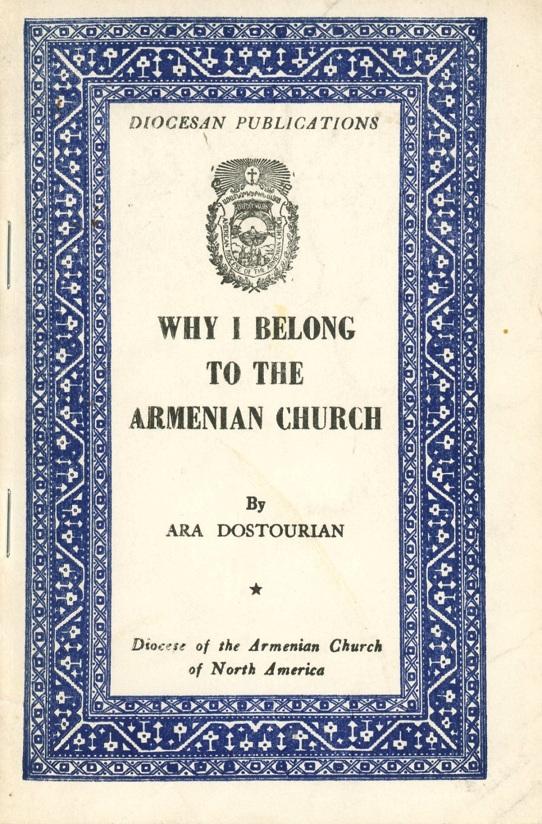 Rangement général
 | | Why I belong to the Armenian Church |
| Titre : | Why I belong to the Armenian Church / auteur(s) : Armenian Church of America - By Ara Dostourian |
|---|
| Editeur : | Armenian Church of America |
|---|
| Année : | 1963 |
|---|
| Imprimeur/Fabricant : | |
|---|
| Description : | 10,5 x 18 cm, 12 pages, couverture illustrée en couleurs |
|---|
| Collection : | |
|---|
| Notes : | |
|---|
| Autres auteurs : | |
|---|
| Sujets : | |
|---|
| ISBN : | |
|---|
| Lecture On-line : | non disponible |
|---|
Commentaire : |
308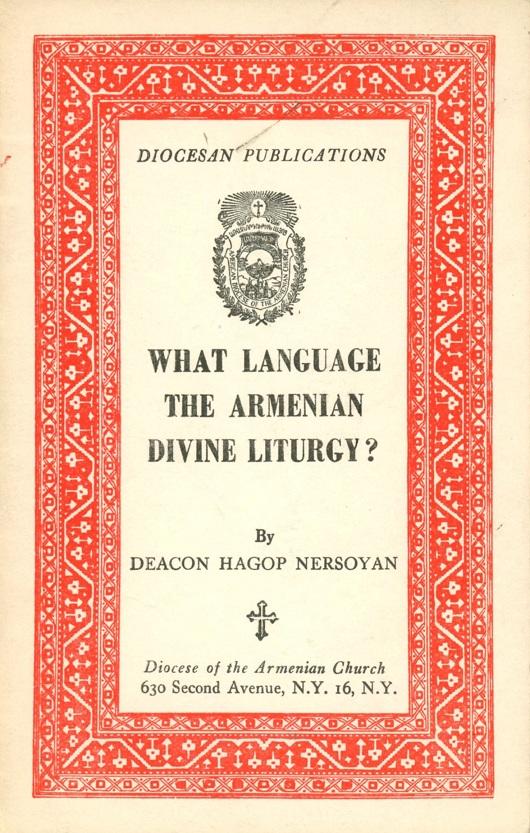 Rangement général
 | | What language the Armenian divine liturgy |
| Titre : | What language the Armenian divine liturgy / auteur(s) : Armenian Church of America - |
|---|
| Editeur : | Armenian Church of America |
|---|
| Année : | 1963 |
|---|
| Imprimeur/Fabricant : | |
|---|
| Description : | 10,5 x 18 cm, 14 pages, couverture illustrée en couleurs |
|---|
| Collection : | Diocesan publications |
|---|
| Notes : | |
|---|
| Autres auteurs : | |
|---|
| Sujets : | |
|---|
| ISBN : | |
|---|
| Lecture On-line : | non disponible |
|---|
Commentaire : |
208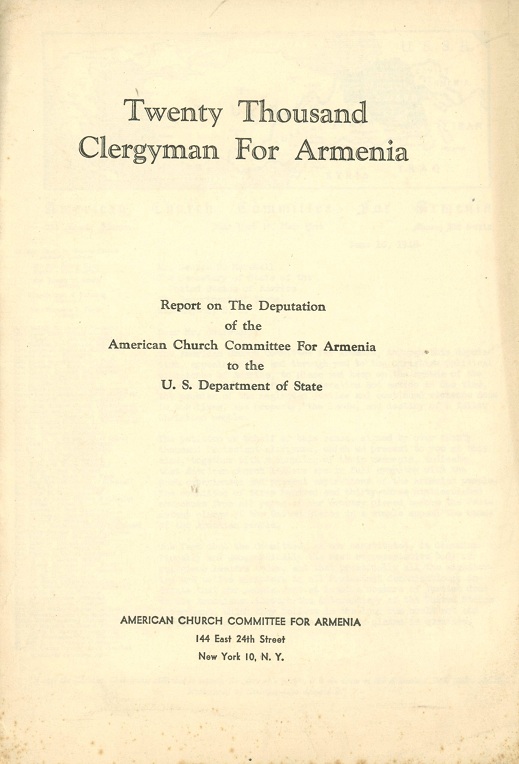 Rangement général
 | | Twenty thousand clergyman for Armenia |
| Titre : | Twenty thousand clergyman for Armenia / auteur(s) : Armenian Church of America - Report on the deputation of the Armenian Chruch Committee for Armenia to the US Department of State |
|---|
| Editeur : | Armenian Church of America |
|---|
| Année : | 1948 |
|---|
| Imprimeur/Fabricant : | |
|---|
| Description : | 15 x 22 cm, non paginé (16 pages) |
|---|
| Collection : | |
|---|
| Notes : | |
|---|
| Autres auteurs : | |
|---|
| Sujets : | A Petition from 20,000 American Clergymen on behalf of the Armenian Cause |
|---|
| ISBN : | |
|---|
| Lecture On-line : | non disponible |
|---|
Commentaire :A Petition from 20,000 American Clergymen on behalf of the Armenian CauseWe, leaders and ministers of various churches in the United States, feeling the full weight of the responsibility that rests upon our shoulders by virtue of our having committed ourselves to serve the highest interests of our fellowmen everywhere, realizing that the only pledge for a sound and significant peace is the implementation of justice in the relations of peoples, and accepting the United Nations as the sole instrument for the arbitration and settlement of the claims and contests between nations, respectfully submit this Petition.
WHEREAS, the Armenians are a distinct and ancient people with a rich historical and cultural inheritance. As long ago as 3000 B.C. the old stock, from which the Armenian nation sprang, occupied the Armenian highland.
Throughout the centuries, the Armenians have courageously struggled to maintain their land and preserve their freedom successively against the Persians, the Romans, the Seljuks, the Mongols and, in recent centuries, the Turks. In the seventeenth century, Armenia was partitioned between Turkey and Persia. During the nineteenth century parts of historic Armenia, including Kars and Ardahan, passed into the sovereignty of Russia.
During the last seventy years the Armenians have suffered their most bitter persecution at the hands of the Turks who attempted to liquidate them.
By the Treaty of San Stefano, 1878, Russia forced Turkey to agree to measures of reform in the Armenian provinces.
By the Treaty of Berlin, 1878, Britain, France and Germany reentrusted the security of the Armenians to Turkey. Turkey then began a systematic massacre of the Armenians. Between 1894-1896 more than 300,000 Armenians were slaughtered. At that time, the first Armenian refugees were received into the United States. In 1909 another 30,000 Armenians were massacred by the Turks in Cihcia.
At the outbreak of World War 1 the Turks thought the opportune moment had arrived to dispose of the Armenian question by exterminating the Armenians. Feeling free of all international restraints, they turned upon the Armenians with fire and sword, murdered more than 1,000,000, drove 1,500,000 into exile and confiscated an amount of property estimated in billions.
During the war the Armenians rendered brilliant and heroic service to the Allies. After the collapse of Russia, single-handed they stood off the effort of the German-supported Turkish might to seize the Baku oil fields. To the failure to gain this source of fuel German General Von Ludendorf attributed the collapse of the German armies in Europe. Said Turkish General Ihsan Pasha — "Had it not been for the Armenians, we would have conquered the Caucasus."
This service to the Allies was acknowledged with high praise by Woodrow Wilson, Clemenceau, Lloyd George, Henry Cabot Lodge, Briand, Premier Poincare, Viscount Bryce, Lord Robert Cecil, Lord Balfour, Kerensky, the Senate of the United States, the British House of Commons, the French Parliament and the Italian Chamber of Deputies.
It was proclaimed that "the liberation of Armenia is one of the war aims of the Allies."
But that liberation has never taken place.
It is true that by the Treaty of Sevres, Turkey agreed to surrender to Armenia such lands as President Wilson should adjudicate. It is true that Wilson drew a boundary that would have restored to Armenia forty percent of Armenian Turkey. But the rivalries of the Allied powers prevented the carrying out of the Wilson award.
Instead of turning the land over to the Armenians, Turkey not only reoccupied Erzeroum, Trebizond, Van and Bitlis in their entirety — but seized Kars and Ardahan as well, murdering their inhabitants. Today, Turkey occupies ninety percent of historic Armenia. The ten percent remaining was for its preservation incorporated into Russia by the surviving 850,000 Armenians. During the subsequent years the million and a half of exiles have been scattered as displaced persons through some thirty nations.
The Christian Church has a profound concern for the Armenians. Armenia, which officially adopted Christianity in 301 A.D., is the oldest Christian nation on earth. Much of the persecution which they have undergone has fallen upon them at the hands of Zoroastrians and Moslems because the Armenians chose to remain faithful unto death The terrible persecution of the first World War shocked Christianity to its depths, and tens of millions of dollars were poured out in relief.
It is time once more for the Christian Church to take up the cause of the Armenians. It is time for the Church to awaken the conscience of the nation to resume its historic concern for the brave and sorely persecuted people. The birth of the United Nations has brought into existence a world tribunal before which the Armenian cause may be pleaded.
THEREFORE, we respectfully and urgently petition you to use the good offices of our government to place the cause of the Armenians before the United Nations Assembly; to plead for the restoration of the land within the Woodrow Wilson award to the Armenian people; and to seek that these people, by their own self-determination, be given the right to decide the political future of their restored land.
SIGNATURES
Signed by 20,000 clergymen of the various Protestant denominations in the United States and by over 300 missionaries and native ordained pastors connected with American missions in 57 countries in all parts of the world. |
209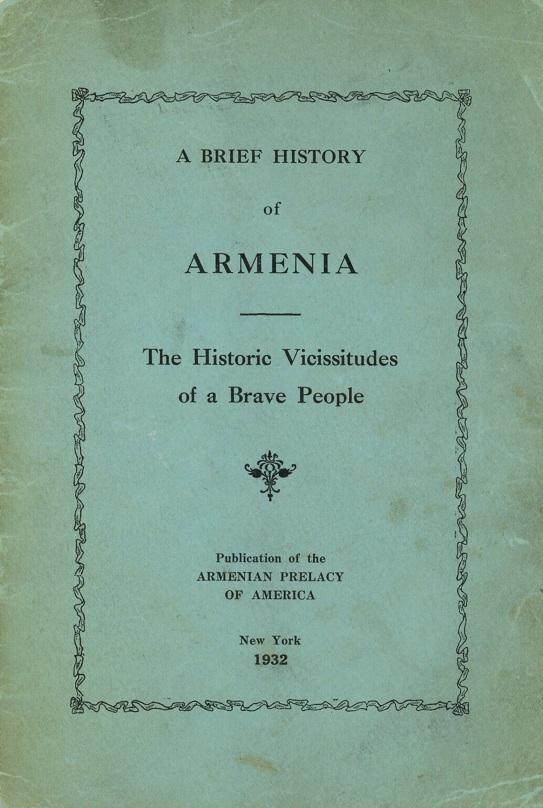 Rangement général
 | | A brief history of Armenia, The historic vicissitudes of a brave people |
| Titre : | A brief history of Armenia, The historic vicissitudes of a brave people / auteur(s) : Armenian Church of America - |
|---|
| Editeur : | The Armenian Prelacy of New York |
|---|
| Année : | 1932 |
|---|
| Imprimeur/Fabricant : | |
|---|
| Description : | 13,5 x 22 cm, 14 pages |
|---|
| Collection : | |
|---|
| Notes : | |
|---|
| Autres auteurs : | |
|---|
| Sujets : | History of Armenia |
|---|
| ISBN : | |
|---|
| Lecture On-line : | non disponible |
|---|
Commentaire :PREFACE
We are sure that this booklet will be of interest to foreigners and appreciated by our Armenian compatriots, who should feel proud of belonging to a nation which although small, yet has given ample proof of many heroic deeds in the long course of its existence.
ARMENIAN PRELACY OF AMERICA |
466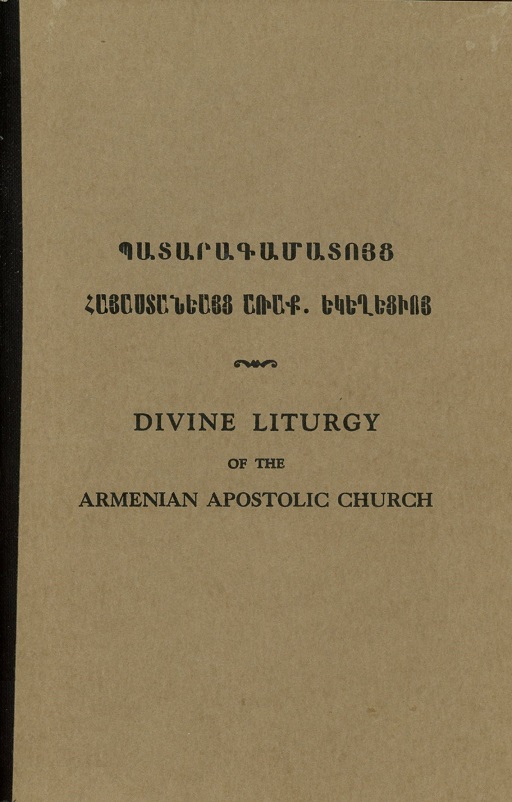 Rangement Bible, etc.
 | | Divine Liturgy of the Armenian Apostolic Church |
| Titre : | Divine Liturgy of the Armenian Apostolic Church / auteur(s) : Armenian Church of America - |
|---|
| Editeur : | Armenian Church of America |
|---|
| Année : | 0000 |
|---|
| Imprimeur/Fabricant : | Printed by Gotchnag Press, New York |
|---|
| Description : | 15 x 23 cm, 65 pages |
|---|
| Collection : | |
|---|
| Notes : | |
|---|
| Autres auteurs : | |
|---|
| Sujets : | |
|---|
| ISBN : | |
|---|
| Lecture On-line : | non disponible |
|---|
Commentaire :Bilingue, arménien-anglais face à face |
|